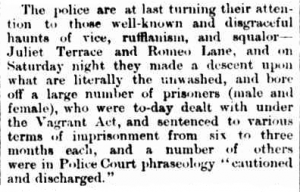In the 1870s Romeo Lane and Juliet Terrace in central Melbourne were home to men and women of the night. Supposedly men would ply their trade in Romeo Lane and the women in Juliet Terrace. The lanes led to Bilking Square, an unofficial name for this infamous red light district. ‘Bilking’ means to cheat someone of money, and here prostitutes would steal the wallets of potential customers. It puts a very different twist on the notion of ‘star crossed lovers’ presented in Shakespeare’s Romeo and Juliet.
1. Another stabbing case [picture] ; 2. Waiting to go on. PN13/10/77/00
Bilking Square was never marked on a map, but everyone knew about it and the seedy nature of what took place there. In A city lost & found : Whelan the Wrecker’s Melbourne, author Robyn Annear states that, ‘All manner of crookdom felt at home in the square: pickpockets, pimps, thieves, magsmen – murderers even’.
Melbourne Councillors renamed the lanes in a futile attempt to cast off the area’s shady past, but brothels continued to flourish. Romeo Lane was renamed Crossley Street in 1876 and Juliet Terrace was renamed Liverpool Street in 1890. Around the time of the First World War, Whelan the Wrecker were called in to demolish Bilking Square. Apparently they uncovered a cart load of fake jewellery; remnants of a fraudulent and tawdry history.
Bendigo Advertiser, 10 January 1871
Over a century later, Melbourne Councillors of the time would be glad to know that the once notorious slum has been completely transformed. Crossley Street is now home to chic boutiques and cafes and Liverpool Street has an abundance of Asian eateries and Italian restaurants. A far cry from the business transactions characteristic of Romeo Lane and Juliet Terrace.
[Man taking the purse from a lady during an embrace, Bourke Street, Melbourne] PN03/03/77/00
Bibliography
1. Annear, R 2005, A city lost & found: Whelan the Wrecker’s Melbourne, Black Inc., Melbourne, Vic.
Written by Sarah Ryan, Librarian, Collection Development & Discovery

![1. Another stabbing case [picture] ; 2. Waiting to go on. Black and white facsimile of a wood engraving showing a woman, named Mrs. Follett, attempting to stab her husband Lewis Follett; two girls waiting backstage for their cue to go on stage.](https://blogs.slv.vic.gov.au/wp-content/uploads/2014/06/romeo-and-juliet-239x300.png)

![[Man taking the purse from a lady during an embrace, Bourke Street, Melbourne] Black and white facsimile of a wood engraving showing the lady, Kyneton Jane, who had exposed the contents of her purse when shouting a drink for Flash Harry, who then robbed her.](https://blogs.slv.vic.gov.au/wp-content/uploads/2014/06/romeo-and-juliet1-207x300.png)

My ancestors lived at 5 Juliet Terrace, in the late 19th century and were Shop Keepers, Wood Carvers and Bell Ringers at the local Churches. What else they did I do not know!! They arrived from Adelaide probably via the Goldfields.
Hi Richard
Thanks for sharing your family connection to Juliet Terrace. Sounds like your ancestors were in the thick of it!
Hi Richard,
My wifes family lived juilet/liverpool st in the 1860. They were Shiells and Sydenham and Grew. Are you related in any way?
Cheers
Sean.
Hi Sarah, My relatives including my great grandfather Henry Thomas Cleary, lived opposite the Oddfellows Hotel in Little Lonsdale St in the 1850’s. A street called M’Grath Place, now Burton St. There are many references in Trove to my family, one of which is the following, which refers to Juliet Terrace:- “BREAKING WINDOWS.-Joseph Rogers was charged with breaking windows, shutters, &c.’, to the value of £3, at the house of one Johanna Cleary in Juliet-terrace. The house was one of ill fame, and a row had taken place inside it ; the prisoner alleging that he was violently assaulted by the prosecutrlx, and some other residents in the house. Rogers was fined 15s”. Life was very tough for my family. I am now passionately following their trail as we had no idea of our past! Would appreciate any advice in pursuing this. Kind Regards, Phil Cleary 0412 413 317
Hi Phil, Thank you for your interest. A librarian will get back to you soon. Sarah